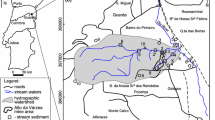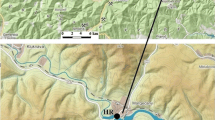Abstract
Mining sediments are excavated from nickel ore exploitation in New Caledonia. In those sediments, chromium (Cr) occurs as Cr(III), but Cr(III) can be oxidized to the toxic Cr(VI) under oxic conditions, for instance in overlying water. Here, we aimed to determine whether mining sediments could release available Cr(VI) in surface waters. Water samples were collected in a mine and in the village downstream, and then were analysed for Cr. Batch leaching experiments were performed on mining sediments in order to determine their exchangeable and their water-soluble Cr content as a function of pH. Results show that mine waters contain high concentrations of total dissolved Cr, of up to 0.73 mg/L. Moreover, Cr(VI) concentration in village waters increases with the rainfall rate upto 0.34 mg/L. Cr is released from sediments solely as Cr(VI). Desorption of chromate complexes is the main process involved in Cr release. We conclude that drainage of sediments mobilized by opencast Ni mines is a source of toxic Cr(VI) for surface waters.



Similar content being viewed by others
References
AFNOR (1996) NF EN 1233, Water quality-determination of chromium- Atomic absorption spectrometric methods
Ahmed MK, Kundu GK, Al-Mamun MH, Sarkar SK, Akter MS, Khan MS (2013) Chromium (VI) induced acute toxicity and genotoxicity in freshwater stinging catfish, Heteropneustes fossilis. Ecotoxicol Environ Saf 92:64–70
Anderson RA (1981) Nutritional role of chromium. Sci Total Environ 17:13–29
Becquer T, Quantin C, Sicot M, Boudot JP (2003) Chromium availability in ultramafic soils from New Caledonia. Sci Total Environ 301:251–261
Deng Y, Stjernström M, Banwart S (1996) Accumulation and remobilization of aqueous chromium (VI) at iron oxides surfaces: application of a thin-film continuous flow-trough reactor. J Contam Hydrol 21:141–151
Fandeur D, Juillot F, Morin G, Olivi L, Cognigni A, Webb SM, Ambrosi JP, Fristch E, Guyot F, Gordon E, Brown JR (2009) XANES Evidence for Oxidation of Cr(III) to Cr(VI) by Mn-Oxides in a Lateritic Regolith developed on Serpentinized Ultramafic Rocks of New Caledonia. Environ Sci Technol 43:7384–7390
Gäbler H-E (1997) Mobility of heavy metals as a function of pH of samples from an overbank sediment profile contaminated by mining activities. J Geochem Explor 58:185–194
Garnier J, Quantin C, Martins ES, Becquer T (2006) Solid speciation and availability of chromium in ultramafic soils from Niquelândia, Brazil. J Geochem Explor 88:206–209
International Agency for Research on Cancer (1990) World Health Organization, Chromium, Nickel and Welding. IARC Monographs on the Evaluation of Carcinogenic Risks to Humans, Volume 49, IARRC, WHO, Lyon, 1990
Marouani N, Tebourbi O, Mahjoub S, Yacoubi MT, Sakly M, Benkhalifa M, Rhouma KB (2012) Effects of hexavalent chromium on reproductive functions of male adult rats. Reprod Biol 12(2):119–133
Meibian Z, Zhijian C, Qing C, Hua Z, Jianlin L, Jiliang H (2008) Investigating DNA damage in tannery workers occupationally exposed to trivalent chromium using comet assay. Mut Res 654:45–51
Mishra AK, Mohanty B (2008) Acute toxicity impacts of hexavalent chromium on behaviour and histopathology of gill, kidney and liver of the freshwater fish Channa punctatus (Bloch). Environ Toxicol Pharmacol 26:136–141
Raous S, Echevarria G, Sterckeman T, Hanna K, Thomas F, Martins ES, Becquer T (2013) Potentially toxic metals in ultramafic mining materials: identification of the main bearing and reactive phases. Geoderma 192:111–119
Richard FC, Bourg ACM (1991) Aqueous geochemistry of chromium: a review. Water Res 25(7):807–816
Rodriguez E, Santos C, Azevedo R, Moutinho-Pereira J, Correia C, Dias MC (2012) Chromium (VI) induces toxicity at different photosynthetic levels in pea. Plant Physiol Biochem 53:94–100
Saputro S, Yoshimura K, Matsuoka S, Takehara K, Narsito, Aizawa J, Tennichi Y (2014) Speciation of dissolved chromium and the mechanisms controlling its concentration in natural water. Chem Geol 364:33–44
Superville P-J, Prygiel E, Magnier A, Lesven L, Gao Y, Bæyens W, Ouddane B, Dumoulin D, Billon G (2014) Daily variations of Zn and Pb concentrations in the Deûle River in relation to the resuspension of heavily polluted sediments. Sci Total Environ 470–471:600–607
Acknowledgments
This work was supported by the National Centre for Technological Research on “Nickel and its Environment” (Centre National de Recherche Technologique, CNRT “Nickel et son environnement”) within the programme “functioning of small mining catchment areas” (2009–2014).
Author information
Authors and Affiliations
Corresponding author
Rights and permissions
About this article
Cite this article
Gunkel-Grillon, P., Laporte-Magoni, C., Lemestre, M. et al. Toxic chromium release from nickel mining sediments in surface waters, New Caledonia. Environ Chem Lett 12, 511–516 (2014). https://doi.org/10.1007/s10311-014-0475-1
Received:
Accepted:
Published:
Issue Date:
DOI: https://doi.org/10.1007/s10311-014-0475-1




